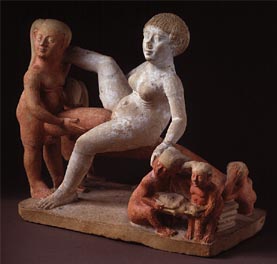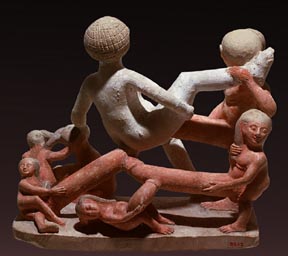

ref.: Nov. 18, "Eroticism in AE?"
Below two views of the Symplegma of the Brooklyn Museum [No. 58.13],
a painted limestone piece
[6 1/2 x 6 11/16 x 3 3/4 (16.5 x 17 x
9.5)] from the Ptolemaic Period (ca. 330 - 305 BCE).
This is from the Brooklyn Museum's description of the piece:
"This symplegma, or group of intertwined figures, is the largest such
erotic group known from ancient Egypt. The focal point of the composition
is a nude woman in a curled wig who is attended by a retinue of six male
figures, each wearing a sidelock. At the front of the composition, to the
right, are two of the attendants, who hold a representation of a bound
oryx. Such an enigmatic composition is at first glance difficult both to
date and to interpret.
The dating of the object is assured, however, by the stylistic similarities
between the central female figure and any number of representations of
women that are securely dated to the Ptolemaic Period. Thematically, the
group is associated with the god Osiris, who posthumously engendered his
heir, Horus, and thereby ensured the continuity of his line. Via a series
of complex visual conceits, the symplegma alludes to that myth. The
components of the allegory are the male figures, identifiable by their
sidelocks as sem priests who traditionally performed the last rites at
Egyptian funerals. The powers of the oryx, symbolizing evil and
destruction, are held in check. These individual motifs, grouped around the
central female figure, represent, by analogy with manís procreative
abilities in life, his potential for resurrection in the hereafter. (R.S.B.)"
The image and information is from the CD-ROM of the Brooklyn Museum, called "Ancient Egyptian Art: Brooklyn Museum", produced by Digital Collections, Inc.
Katherine Griffis
grifcon@mindspring.com

